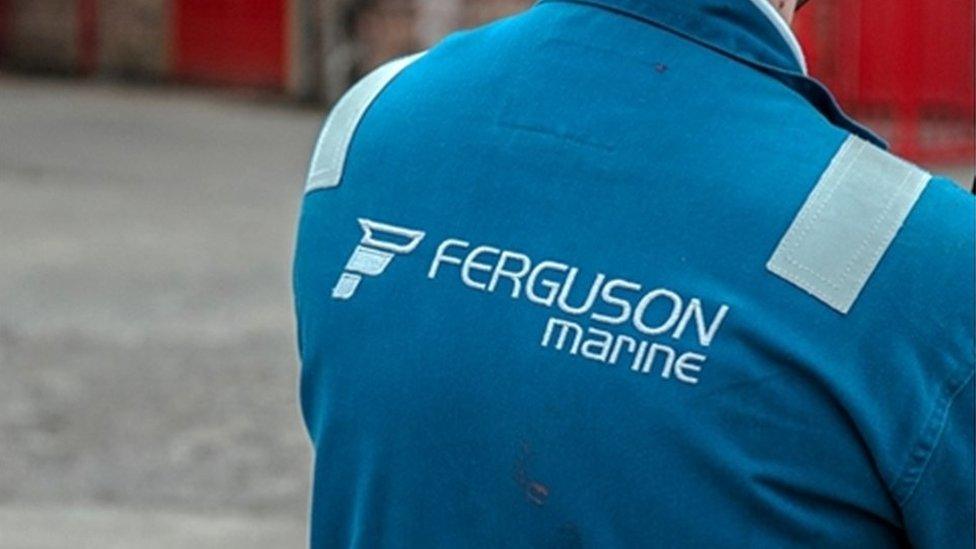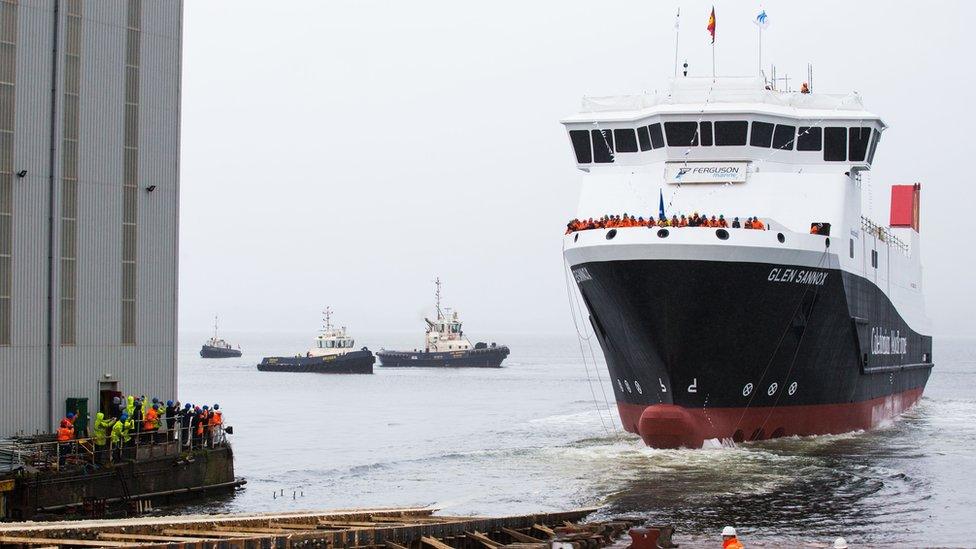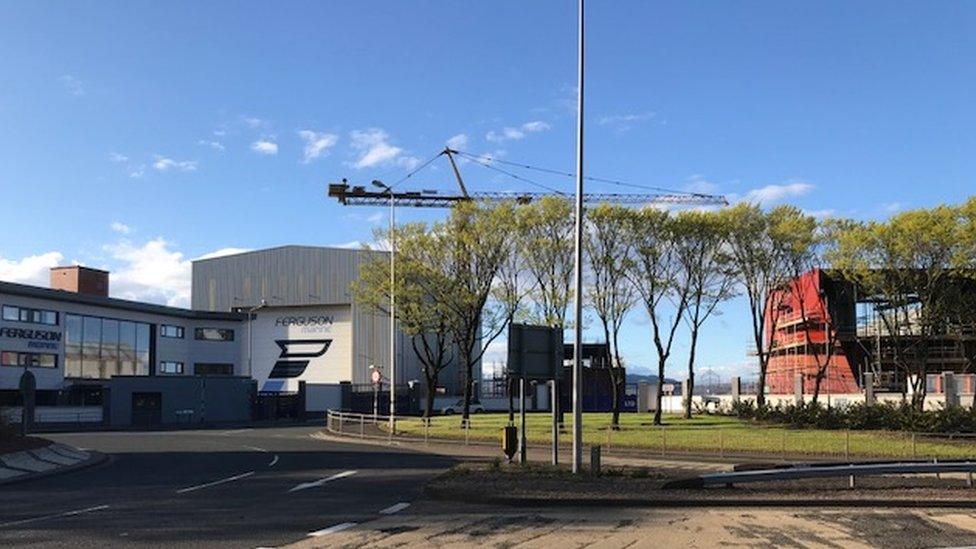Roll-on Roll-off Over-spend Fall-out
- Published

Innovative ships being built for Hebridean and Clyde ferries are at the centre of a dispute between shipbuilders and the government-owned purchaser
Concerns are being raised about the decision to use liquified natural gas for environmental reasons
The Cal-Mac fleet needs renewal, but the dispute puts at risk the chances that new ships will be built in Scotland
There's something far from seaworthy about the next ship deliveries for Cal-Mac.
They'll float, as far as I know. One of them, the Glen Sannox, is already doing so, at the quayside in Port Glasgow, while it is fitted out.
It's the relationship between customer and shipbuilder that is holed below the waterline.
And if it isn't fixed, there's a serious risk that subsequent orders for the Hebridean and Clyde ferry operator will have to be built at a foreign yard.
Without resolution of a big disputed bill, it's unlikely Ferguson Marine - the only Scottish shipyard tooled up for that size of ferry - will bid for further contracts from Caledonian Maritime Assets Limited (CMAL), the company that leases ships to Cal-Mac.
There are personality clashes. And there's a political problem here. The Scottish government owns Cal-Mac, and is under pressure from island communities to modernise the fleet to improve reliability, add capacity, and keep a spare boat or two on standby.
It also owns all of CMAL. Having been told by European Commission officials that contracting for ferry operations should be open to competitive tender, the former Labour-LibDem government split the two functions into separate companies.
Totemic
Then there's Ferguson's Marine - like BiFab, one of those totemic Scottish businesses, currently employing 350, that Scottish ministers politically can't afford to let sink.
It became all the more significant when it was rescued from collapse in the days before the 2014 independence referendum, with Jim McColl the hero of the hour.
That helps explain why £45m has been loaned by ministers to Ferguson Marine. Different reasons have been given at different times, but it seems most likely to have been something to help the shipyard through the cost overruns on its current contract for CMAL.
As he explains here, the boss of CMAL, Kevin Hobbs, believes he's stuck to the tender specifications on a fixed price contract. He's got the task of protecting the public purse, and he says this prestige contract is failing to showcase Scottish shipbuilding as it could.
The problem may be that the specifications were vague, and while the ships had not been designed, the contract appeared to put the risk of cost over-run with Ferguson, but not all the controls.

The delayed ferries are at the centre of a row between Ferguson Marine and the Scottish government's ferry company Caledonian Maritime Assets Ltd
The ships were to use a combination of liquified natural gas (LNG) in a hybrid arrangement with diesel. That's been tried elsewhere before, but had to be reinvented by Ferguson, as it could not tap the intellectual property from those foreign yards with experience of this.
The designs then had to be approved by the client, and by maritime safety regulators. Sources at Ferguson say that there have been hundreds of changes to the design, and approval from CMAL has been slow.
The contract was for £97m, but insiders say the overrun is now looking more like £70m.
Mr Hobbs, meanwhile, portrays the changes as minor, at a cost of around £1.5m.
That's a wide gulf in perception, making for a lively case when the lawyers get stuck in - as it seems they inevitably will.
Until there is a promise of no further changes to design, Ferguson is refusing to give a date for handover.
Methane slip
The challenges with this project don't stop there. LNG is a new technology for fuelling ships.
It is cleaner than diesel, notably on nitrogens oxides, sulphur oxides and particulates. It produces up to 25% lower carbon dioxide than diesel.
When a ship is coming into port, it needs the traction of a diesel engine. Switching off the LNG and firing up the diesel means that a plume of unburned methane goes up the funnel, which is far more climate-changing than diesel fumes.
That's seen as an acceptable price to pay for the benefit of low emissions for ships that cross oceans and are not docking frequently.
But - and Scottish Labour has picked up on this - on the short crossing from Ardrossan to Brodick, the regular blast of raw methane as the new ship docks could far outweigh the benefit of using LNG during the crossing.

And what of the tanks required at each quayside served by these ships? The European Commission has put more than £200m into getting that infrastructure in place across the EU. An expert (and contested) report last year said it was wasting its money, as LNG would not deliver the environmental benefits claimed for it.
Even if CMAL and Cal-Mac get all the permissions necessary to operate at Brodick and Ardrossan, the LNG option is not available if the ship is moved to other routes.
So whether it's because of the "methane slip" or the limited number of routes with LNG quayside tanks in place, these hybrid ships may end up only using diesel - their innovative and expensive LNG capacity being left all but redundant.
Hotch-potch
Ferguson and other yards around the world which want to focus on innovation are more interested these days in developing hydrogen technology for ships. It also plans to get a share of the next Royal Navy frigate order, which is being built at multiple yards. It doesn't want to be reliant on CMAL and Cal-Mac.
Government ministers will surely want Cal-Mac ferries to be built at the Port Glasgow yard. That's if CMAL can get the price right, in competition with specialist and volume ferry-builders in Germany and Poland.
But getting the price right requires standardised designs for future Cal-Mac ships, so that the yard can gain from the efficiency of repetition on a sort of assembly line. It's a similar challenge for BiFab to get up to scale on fabricating steel platforms for offshore wind turbines.
A more efficient ferry operator also requires standardised crewing, to make the Cal-Mac workforce more flexible across ships. At Serco, the company which lost out to Cal-Mac on the franchise bid, they have a reputation for bearing down on terms and conditions of staff. But even by the public sector standards they've found elsewhere, they were astonished to find the rostering conditions for Cal-Mac.
The Cal-Mac fleet that offers an island Hopscotch has always been a Hebridean hotch-potch of ships. It has long sweated its older ships beyond their optimal retirement age.
Trying to modernise it is a project for the next 20 to 30 years. Its early stages are proving to be an expensive bùrach.
- Published15 March 2019
